Polish chicken breed profile.

I have kept Polish chickens for a great many years now. Although I have never bred them for show and just keep them around because I like to have them in my flock.
I have found them to be average layers with a good nature but needing some extra attention in winter.
Table of Contents
- What is the Polish chicken?
- Polish or Poland chicken breed overview:
- What do Polish chickens look like?
- Brief history of the Polish:
- Breed FAQ:
- Where to get Polish chickens and how much to pay for them:
- Breeding the Polish chicken:
- Coops and housing for Polish chickens:
- Feeding Polish chickens:
- Sexing Polish chickens:
- Colours of Polish chickens:
- Polish breed standards:
What is the Polish chicken?
The Polish or Poland is one of the oldest breeds of European chickens known for its remarkable crest of feathers.
The oldest accounts of these birds come from the Netherlands and their exact origins are much disputed.
Below: A young Polish cockerel with my mixed flock.
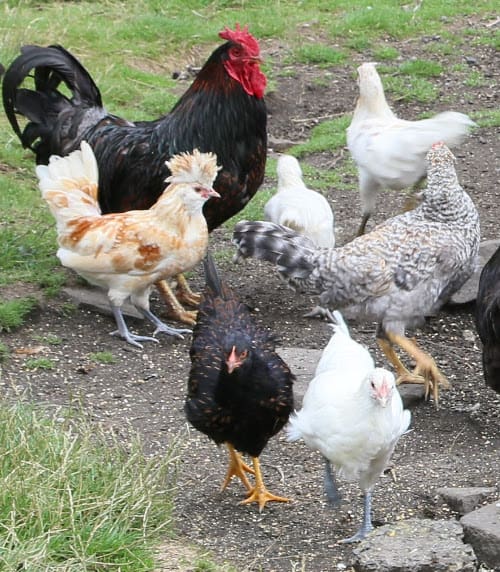
Polish chickens are bred primarily as a show bird, but were originally productive egg layers. Accordingly, Polish rarely go broody and are noted for the quality of their smallish white eggs.
There are bearded, non-bearded and frizzle varieties.
The body of the Polish should be symmetrical and of fair length with well-rounded breast, the back showing a distinct slope backwards from the shoulders to the tail.
Polish or Poland chicken breed overview:
Primary use: Ornamental and exhibition.
Conservation status: Poland's are on the watch list at the livestock conservancy.
Size: Both standard or large fowl and bantam versions
Weight: Male:Standard: 2.75 kg Bantam: 850 g Female:Standard: 2 kg Bantam: 740 g
Origin: Continental Europe in the 1500's
Eggs: 100-140 white eggs per year.
Class: rare breed
Temperament: Good and well mannered. The large crests that cover the entire head limits their vision somewhat and they may be timid and easily frightened.
Cold hardy: No, needs extra shelter in cold and damp conditions.
Colours: Black, blue, cuckoo, white, splash, buff laced or chamois, gold laced, Silver laced.
Broodiness: Rarely go broody
Productivity: Average
Availability: Difficult to find except from breeders and clubs.
Useful to Know: Birds are active and lively but the crest can mean they can't see properly and may fall prey to predators more easily as well as being startled easily
What do Polish chickens look like?
Polish chickens are lightweight for their size and of fine build.
The Polish has a small V-shaped or duplex comb, though it is often hidden by the large crest of feathers. The earlobes and wattles are small and may also be completely hidden by the crest and beard.
The earlobes are white, the comb and wattles bright red and the legs are slate in colour.
Breed images:
Below: A polish hen.
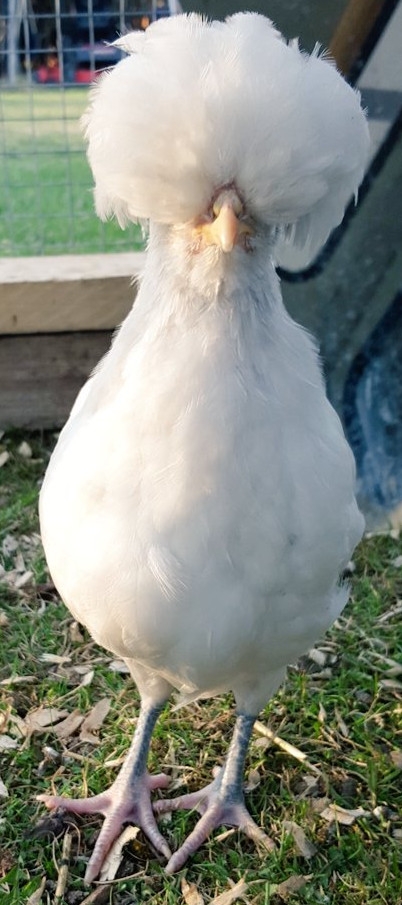
Below: A buff laced or chamois Polish cockerel.
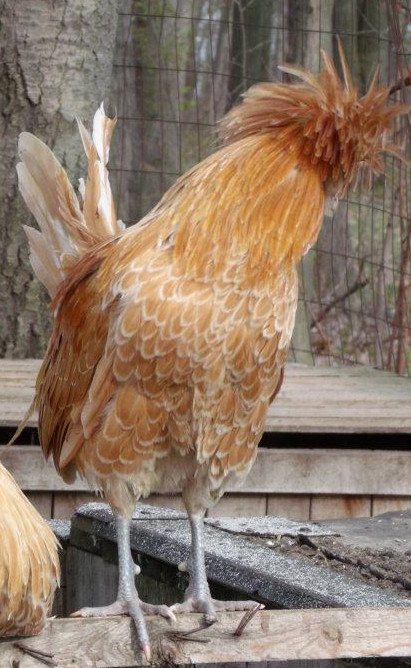
Below: A day old Polish chick. Note the crest fluff and the clean slate legs.
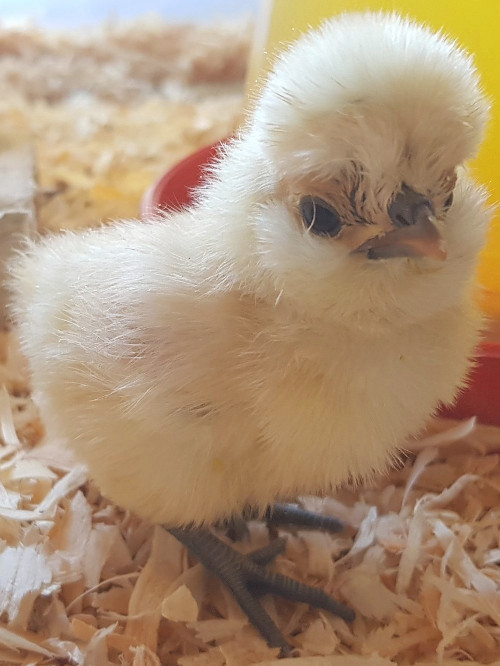
Below: Polish chicken eggs.
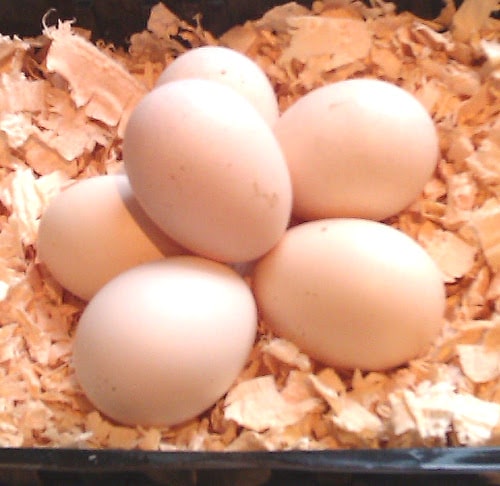
Brief history of the Polish:
Though the original lineage of the Polish breed is unclear, one theory suggests that their ancestors were brought by Mongols to Eastern Europe during medieval times, so could have originated in what is now Poland.
Below: A picture of a white crested black Polish hen from 1886.
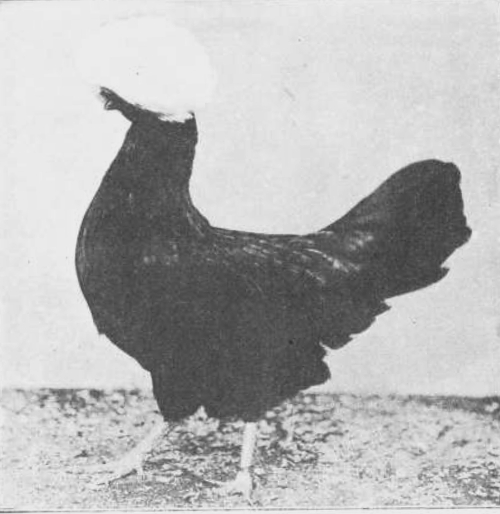
Trade flourished Across Europe and the east since Roman times and chickens are one of the species that made their way across the continent.
The Polish was standardised in the Netherlands in the 16th century and there are paintings from the 15th century which could easily be recognisable as the modern Polish birds.
The American Poultry Association states that the breed was introduced to America between 1830 and 1840. The breed was, during a certain period of time, favoured by American farmers and chicken fanciers. The American Poultry Association accepted three Polish varieties into the American Poultry Association's Standard of Perfection in 1874; additional varieties were accepted in 1883, 1938 and 1963
Breed FAQ:
What colour eggs does the Polish chicken lay?
Both the bantam and large fowl Poland lay a white egg. The egg is of average size for the bird and the modern type is not overly productive. The odd bird can produce a slightly pale brown colour as well, usually from the black feathered birds.
Are Polish chicken good layers?
Though usually only a fair layer at best today, In France they were once known as an excellent producer of eggs.
How many eggs does a Polish chicken lay?
Expect a maximum of 140 eggs in the first full year, dropping by 15% after every moult.
How old are Polish chickens when they start laying eggs?
They are not quick to mature and require 26 weeks or more before they come into lay.
Are Polish chickens friendly?
Mine always have been. They are happy around people and very trusting, I suppose you have to be when you can't see very much of the world.
Below: As you can see from this one, Polish chickens are friendly and like human company.

I find the way they tilt their heads to the side to look up at me very endearing.
How big is a Polish chicken?
The Polish bantam is around 10 inches tall for the hen and 12 inches tall for the cockerel. Standard fowl Polish chickens are 16 inches tall for the hens and 18 inches tall for the cockerels. The crest make them appear taller and bigger than they are.
The ideal weight for the standard fowls:
- Male 2.70 - 3.20 kg (6 - 7 lb)
- Female 2.00 - 2.5 kg (4 ½ - 5 ½ lb)
The ideal weight for the bantams:
- Male 790 - 910 g (28 - 32 oz)
- Female 680 - 790 g (24 - 28 oz)
Where do Polish chickens come from?
The only thing we know for definite about the origin of the Polish chicken is they first appeared in northern Europe in the 1500's
The breed could have been named after the country of Poland. Its name also could have come from the Middle Dutch word pol, meaning "head", in reference to the Polish dome-shaped skull.
Do Polish chickens need any special care?
Polish chickens need a little special care. They are often picked on in a mixed flock and their crests feathers can be a target.
Winter is that time where birds may not seem as active and require large amounts of energy to stay warm. It is also a critical time from a dietary point of view as the nature of that storage can determine the success or otherwise of the commencement of breeding.
The greatest challenge is that of heat loss in smaller and less well built chickens with non feathered legs like the Poland. The birds can cope admirably with very cold conditions but need to be protected from wind chill.
High protein feed, sprouted wheat, greens and husked sunflower seed helps to keep the birds active. A full crop at days' end is very important. Don't be surprised if they go through more feed.
Don't try to force birds to lay to early. The hens may lay but cockerel fertility is not reliable during & during & after prolonged cold weather.
Heavily crested birds are more susceptible to cerebral hernia on hot days. We recommend taking them into a cooled room in the morning until the heat of the day is over.
A bird's immune system is challenged during weather extremes so periodic treatment of the water with vitamins should help keep Mycoplasma and other respiratory conditions at bay. Avoid overcrowding and watch for coccidiosis and coryza.
Lice can be a problem with heavily feathered and crested types. Check regularly as no matter where you are, or how clean you keep your pens, at some stage your birds may get lice, sometimes bought in by wild birds. Any lice that are found need to be treated immediately.
Like all other chickens , the Poland like a good dust bath in a dry spot.
Polish chickens have been associated with crooked beaks and malformed toes in the past.
Below: Crooked beak on a Polish hen.

Below: Malformed toes on a Polish cockerel.
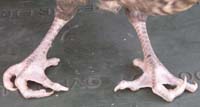
Both can be avoided with good breeding selection and practices.
How long do Polish chickens live?
They seem quite short lived, mine have never done more than 8 years and mostly average only 5 or 6. Maybe having a big pom pom on your head and getting frightened all the time kills them off early.
How much space do Polish chickens need?
Less than most chickens and they are happy to be confined. As long as they are well fed and kept dry and warm it may even be better to keep them in instead of letting them out.
Mine free range with my egg flock and are left to their own devices to farage at will.
Are Polish roosters aggressive?
I have never had an aggressive Polish cockerel but I've not had a great number over the years. Also my surplus males go off to be grown on for processing so the numbers of males in my flock is limited.
Are Polish hens broody?
Polish chickens do not, as a rule go broody, therefore if you wish to breed, you will have to either purchase or make an incubator or use a chicken that is broody by nature.
I have been thinking back and I haven't got a single case of a Poland going broody and raising a clutch and while I haven't got that many I would still have expected the odd one or two in the last few years. If you get a broody one, consider it special and watch it like a hawk as they are unreliable sitters and may not finish.
Is the Polish chicken good for meat production?
They are never going to a large meal and I certainly would not think to ever make a profit raising the Poland for meat.
I have a friend who takes large numbers of my surplus cockerels to raise on for meat and that has included Polish cockerels from time to time. They are a small bird, on the one per person serving size but they taste just like chickens and the quality of the meat is good as long as you don't let them get too old before processing.
He is happy with bantams for the roasting tray, he puts a few rashers of streaky bacon over the top and cooks as normal.
Where to get Polish chickens and how much to pay for them:
You can find Poland to buy on Facebook groups, from specialist breeders and some hatcheries sell day old chicks. You may also be able to buy hatching eggs from eBay or Etsy and have them shipped to you.
Hatching eggs for polish chickens start from $2 each plus postage but may cost as much as $5 each for quality stock.
Day old Polish chicks start at $4 for hatchery quality but expect to pay up to $10 for chicks from show quality birds.
You can add roughly a $1 a week as the chickens age and sexed point of lay Poland could easily be $60 to $80 a pair.
Breeding the Polish chicken:
Breeding Polish chickens can be a little problematic at times as the cockerels pull the crest feathers out during mating.
I like to breed from early spring to early summer as I find chicks hatched later suffer in the shortening days, the chicks seem to grow quicker & be stronger healthier birds when bred as early as possible in the season.
Always try to breed self colours and not to mix them with the white crested types as this will cause problems with the colouring in the crests and may also give them beards. The white crested is dominant.
If you breed black to blue you will get 50% blues, 50% blacks. You will also find that the blue colouring in the offspring will be a stronger, deeper blue. If you breed blues to blues, then you will produce 50% blue, 25% black & 25% splash. It should be noted that the blues will become lighter with continual breeding over time. Eventually you will need to put a black male in to regain the strong blue colouring.
If you breed black to splash you will get 100% blue Polish.
You will get better and more defined cuckoo colouring if you breed cuckoo to black.
Ideally you can have one cock bird with 6-8 hens and try to only breed with 2nd year layers, pullets tend to lay eggs that are not large enough to get good strong chicks.
Coops and housing for Polish chickens:
Damp, wet and windy conditions are the enemy of chickens like the Polish. Keep them out of draughts and off damp and wet ground. This means you may have to keep them confined in your winter.
Housing conditions for the Poland are much the same as for other chickens although you may want to use ladders so as they can get to perches as they tend not to fly if they can't see through the crest. I have taken to using sand on the floor of my coop and run.
Nesting and perching happens just like it would with any other breed.
Never have young Polish chicks running with adult birds and try to keep a growers pen away from the adults. Young polish can be bullied incessantly by older birds and it may effect their outcome.
Feeding Polish chickens:
As a breed Polish chickens need to be well fed with a quality feed and do not do well on scraps. They do like to forage and thrive on pasture.
As chicks from hatching to two months of age, I give them medicated chick starter crumb and some chopped cooked egg.
When they start to grow up 2 - 6 months, they are given a mixture of the starter crumble and growers pellets for a couple of weeks, then they are weaned off the starter and left on the growers pellets. You can also start to introduce them to new foods like fruit, sprouts and vegetables.
After 6 months they can go onto a layers pellets with or without milled seeds in combination. I prefer to wait until they start laying before swapping over to the layers pellets. I usually add some high protein ration in the breeding season or during the moult.
When it is not breeding season, they can be given a combination of grains or a lower protein ration. Cold weather need calories.
Always give them a variety of interesting foods along with their crumble or pellets, this gives them their natural instinct to forage. I have found you should not put the grains in with the layers as the chickens will tend to pick out their favourite grains and flick the layers out to be wasted.
Try to avoid giving too much corn or sunflower to hens coming into late spring early summer, as this will lay down too much fat in the bird, which will make coping with a hot summer even more difficult.
Always have clean, cool water for your flock. This may be a waterer that you manually fill or may be a drip system that automatically waters the birds but I find it better to avoid containers where they can dunk their whole heads in. Some Polish have a fascination for open containers and just love to dunk their crests in, particularly on a hot day which is not good if you are preparing for a show.
Sexing Polish chickens:
This is difficult and Polish chickens are not autosexing. I have a rooster called Beatrice so even the most seasoned of us make mistakes.
Apparently you can sex Polish chicks by the shape of the fluff on the head at hatching, round head for girls and square head for boys.
Polish are pretty easy once the crest grows. Pointy crest feathers is rooster, rounded crest feathers is hen.
As chicks, there is the theory of thicker legs are going to be a male, the more delicate slender leg will be a female.
Females tend to feather up more quickly than males.
Males get bigger and redder wattles and comb and they colour up faster than the hens.
Read more on sexing chickens - https://cluckin.net/sexing-chicks-10-ways-that-work-and-8-that-do-not.html
Colours of Polish chickens:
Not all colours and patterns will be allowed everywhere, it will depend on your breed standards for the poultry association in your country. Below are some of the Polish chickens colours and feather types you are likely to come across:
Black:
The male and female plumage should be black throughout all sections with beetle-green sheen. Under colour as dark as possible.
The requirements are:
Beard - black.
Beak - dark blue or horn.
Eyes, comb (preference for no comb) and face - red.
Ear-lobes - white.
Legs and feet - dark blue.
White-crested Black:
The White-Crested Black Polish is a non-bearded variety. The colour of the plumage is black with a greenish sheen, except for the crest, which is white. Such a combination of plumage colouration makes this variety strikingly attractive. The under-colour in all sections is dull black. The beak is bluish black and the shanks and toes are dark slate.
In the White-crested varieties, the crest must be all white except for a small band of colour in the front, being the same colour as the body of the bird, example is the White-crested Black above.
Male and Female Plumage: Rich black with a beetle-green sheen, except the crest which is snow white, with a a black band at base of crest in front.
Requirements:
Non-bearded - red wattles.
Beak - dark blue.
Eyes, comb (preference for no comb) and face - red.
Ear-lobes - white.
Legs and feet - dark blue.
Blue:
Male and Female Plumage: Blue throughout all sections.
Requirements:
Beard - blue.
Beak - dark blue or horn.
Eyes, comb (preference for no comb) and face - red.
Ear-lobes - white.
Legs and feet - dark blue.
White-crested Blue:
Male and Female Plumage: Solid dark blue (self coloured). Crest snow white, with a a blue band at base of crest in front.
Requirements:
Non-bearded - red wattles.
Beak - dark blue.
Eyes, comb (preference for no comb) and face - red.
Ear-lobes - white.
Legs and feet - dark blue.
Cuckoo:
Male and Female Plumage: Barred white & grey plumage.
Below: A cuckoo Polish.

Requirements:
Beard - barred white and grey.
Beak - dark blue or horn.
Eyes, comb (preference for no comb) and face - red.
Ear-lobes - white.
Legs and feet - dark blue.
White-crested Cuckoo:
Male and Female Plumage: Barred white & grey plumage, except the crest which is snow white, with a barred band at base of crest in front.
Below: A white crested Cuckoo Poland.

Requirements:
Non-bearded - red wattles.
Beak - dark blue.
Eyes, comb (preference for no comb) and face - red.
Ear-lobes - white.
Legs and feet - dark blue.
White:
The Bearded and Non-Bearded White Polish and the Bearded and Non-Bearded White Polish Bantams have white plumage colour and white under-colour. The beak is dark horn, and the shanks and toes a slate blue.
Male and Female Plumage: Pure white throughout all sections.
Requirements:
Beard - white or Non-bearded - red wattles.
Beak - dark blue.
Eyes, comb (preference for no comb) and face - red.
Ear-lobes - white.
Legs and feet - dark blue.
Splash:
Male and Female Plumage: Predominantly White with various shades of Black, Blue & Grey throughout the feathers.
Requirements:
Beard - white, black and blue splashes.
Beak - dark blue.
Eyes, comb (preference for no comb) and face - red.
Ear-lobes - white.
Legs and feet - dark blue.
Buff Laced or Chamois:
Male Plumage: Buff ground with white lacing. Crest white at the roots and tips, and as free a possible from whole white feathers. Muffling mottled or laced, not solid buff. Hackle tipped. Wing bar and secondaries laced, and primaries tipped. Tail, sickles and coverts laced.
Female Plumage: Except that the wing primaries are tipped, the colours and markings including the crest, are buff ground and white lacing.
The Buff-Laced Polish and the Buff-Laced Polish Bantam are bearded varieties, the buff plumage colour being laced with a paler buff. The sexes differ slightly in colour pattern, some sections in the male being a somewhat richer than in the female. The primary wing feathers of the female are plain without any lacing, whereas those of the male are laced, with a paler buff on the outer ends only.
The breast feathers of the male are of a richer buff colour than in the female. The under-colour of both sexes is a pale buff throughout. The beak is slate blue and the shanks and toes are slate blue.
Requirements:
Muffling - mottled or laced, not solid buff.
Beak - dark blue or horn.
Eyes, comb (preference for no comb) and face - red.
Ear-lobes - white.
Legs and feet - dark blue.
Gold Laced:
The Bearded Golden Polish and the Non-Bearded Golden Polish of normal size and the Non-Bearded Golden Polish Bantam are three varieties that have the same colour pattern. The male and female in each variety are identical in this respect. The plumage is golden bay, laced with black throughout.
Male Plumage: Golden bay ground with black markings. Crest: black at roots and tips, and free as possible of whole white feathers. Hackle tipped. Back and saddle distinctly laced or spangled at the tips. Breast, thighs, shoulders and wings: laced except primaries which are tipped. Tail laced, the ends of the sickles well splashed.
Female Plumage: Golden bay ground with black lacing, each feather distinctly marked and free as possible from splashes.
Requirements:
Muffling - mottled or laced, not solid black.
Beak - dark blue or horn.
Eyes, comb (preference for no comb) and face - red.
Ear-lobes - white.
Legs and feet - dark blue.
Silver Laced:
Male Plumage: Silver ground with black markings. Crest: black at roots and tips, and free as possible of whole white feathers. Hackle tipped. Back and saddle distinctly laced or spangled at the tips. Breast, thighs, shoulders and wings: laced except primaries which are tipped. Tail laced, the ends of the sickles well splashed.
Female Plumage: Silver ground with black lacing, each feather distinctly marked and free as possible from splashes.
Requirements:
Muffling - mottled or laced, not solid silver.
Beak - dark blue or horn.
Eyes, comb (preference for no comb) and face - red.
Ear-lobes - white.
Legs and feet - dark blue.
Frizzled Polish: These birds to conform to the Polish Standard in all respects for type and colour. Their frizzled plumage is made up of feathers which are curved back towards the head; the curl as close, even and abundant as possible.
In the Bearded varieties, the wattles are covered over or are very small with a beard & muffle, example is the Self Blue to the left.
In the Non-bearded varieties, the wattles must be able to be seen & be red in colour, example is the White-crested Blue to the right.
Polish breed standards:
Carriage: Sprightly and upright.
Back: Fairly long, flat and tapering to the tail.
Breast: Full and round. Flanks deep.
Shoulders: Wide.
Wings: Large and closely carried.
Tail: Full, neatly spread, and carried somewhat low, not perpendicularly, the sickles and coverts abundant and well curved.
Head: Large and decidedly pronounced protuberance on top, and crested.
Crest: Large, full, circular on top and free of any split or parting, high and smooth in front and compact in the centre, falling evenly with long untwisted or reverse-faced feathers far down the nape of the neck, and composed of feathers similar to those of the hackles.
Beak: Medium length, and having nostrils rising above the curved line of the beak.
Eyes: Large and full.
Comb: Of horn type and very small if any (preference should be given to birds without a comb).
Face: Smooth, without muffling in the White-crested Black or Blue varieties, and completely covered by muffling in the others. White Polish are found in two forms, both bearded and non-bearded.
Muffling: Large, full and compact, fitting around to the back of the eyes and almost hiding the face.
Ear-lobes: Very small and round, quite invisible in the muffed varieties.
Wattles: Rather large and long in the White-crested and non-bearded varieties; the others are without wattles.
Neck: Long with abundant hackle coming well over the shoulders.
Legs and Feet: Slender and fairly long, the shanks free of feathers with four well spread toes.
Female Characteristics: With the exception of the crest, which is of globular shape, the general characteristics are similar to those of the male allowing for the natural sexual differences.
Serious Defects: Split or twisted crest. Comb, if any, other than horn type. Absence of muffling in Chamois, Golden and Silver varieties. Legs other than blue or slate. Other than four toes on each foot. Any deformity. Absence of black or blue in the front of crest in White-crested Blacks and Blues.
Scale of Points:
White-crested Varieties and Non-bearded Whites:
Type - 5
Head (crest 30, comb and wattles 15) - 45
Colour - 30
Condition - 15
Size - 5
TOTAL: 100
Other Varieties:
Type - 10
Head (crest 30, muffling 10) - 45
Colour and markings - 30
Condition - 10
Size - 10
TOTAL: 100
